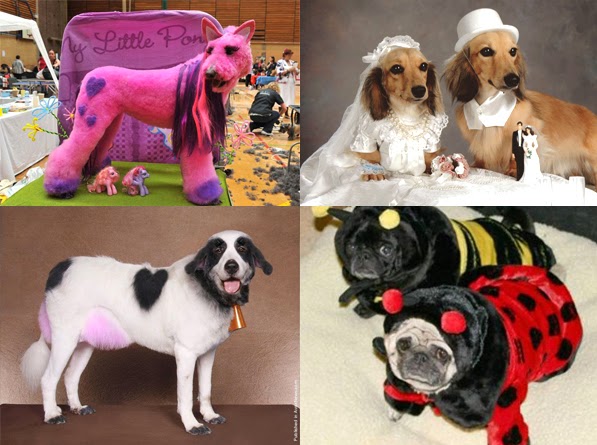The practice of dressing up pets has burgeoned into a multifaceted phenomenon, frequently oscillating between the realms of fashion and perceived animal humiliation. In numerous households, adorning pets in an array of garments, from playful costumes to elegant attire, has become a popular pastime. This trend raises an imperative question: does dressing up animals constitute a form of animal cruelty, or is it simply an indulgence in the whimsical world of pet fashion?
At its core, the fascination with pet fashion can be attributed to the desire for companionship and the expression of personality. Pets are often regarded as family members, and owners may feel compelled to project their own interests, aesthetics, or social status onto them. This relationship can engender a deep emotional connection between human and animal, leading to a shared experience that many perceive as mutually enjoyable. Yet, beneath this seemingly innocuous surface lies a sedimentary layer of interrogations regarding consent, comfort, and the psychological ramifications for both owner and pet.
One must begin by examining the psychological and physical well-being of pets subjected to sartorial choices. From a physiological standpoint, certain animals possess fur coats designed to provide insulation and protection against environmental conditions. The imposition of clothing, particularly items that restrict movement, punctuates a deviation from their natural state. It is crucial to note that not all pets respond favorably to apparel. For some animals, the sensation of wearing clothing can induce substantial stress, anxiety, or discomfort. This phenomenon begs the inquiry: how do pet owners discern between their own aesthetic pleasures and the animal’s welfare?
A significant factor contributing to the normalization of pet fashion is the anthropomorphism—the attribution of human characteristics to non-human entities. Owners frequently attribute emotions and preferences to their pets, often disregarding the innate behavioral instincts that characterize these animals. This inclination to humanize pets can obscure the line between enjoyable interaction and coercive imposition of human desires onto animals, potentially tipping the scales toward what may be classified as a form of cruelty.
It is essential to differentiate between casual and competitive dressing. The casual adornment of pets—occasional costumes for holidays, for instance—typically elicits smiles and amusement without intent to harm. However, competitive pet parades and beauty contests often elevate the stakes, transforming aesthetic enjoyment into a pursuit of superficial accolades. The resultant pressure can lead owners to prioritize image over intrinsic pet well-being, potentially fostering environments that verge on exploitation.
Moreover, societal influences cannot be disregarded. Social media platforms have amplified the allure of pet fashion, with images of impeccably dressed animals garnering likes and shares. This phenomenon introduces an additional layer of complexity, as it creates communal validation for pet owners who engage in this practice. However, the ramifications of seeking social acceptance through a pet’s appearance can detract from the genuine bond that should exist between owner and animal. The necessity for external validation can distort perceptions of what constitutes appropriate animal care.
In extreme instances, pet fashion can even lead to instances of abuse, whether intentional or incidental. For example, some pet garments insist upon restrictive fittings or incorporate elements that can become hazardous, such as heavy embellishments or choking hazards. Such garments can compromise mobility, cause abrasions, or escalate anxiety in already skittish animals. Reconciling the playful nature of dressing up with the potential for harm becomes an ethical consideration—one that every pet owner must navigate carefully.
Furthermore, the commercial industry surrounding pet fashion perpetuates certain narratives that can skew the perceptions of pet ownership. Advertising often idealizes the notion of dressed-up pets, framing such practices as quintessentially loving acts of care. This marketing strategy becomes problematic when it promotes the idea that animals must be adorned to be valued or cherished. In effect, it commodifies companionship, reducing the intrinsic worth of animals to their external appearance. Such a cultural shift can breed irresponsible behaviors among consumers, leading to the normalization of practices that might otherwise be scrutinized.
Understanding the distinction between mere enjoyment and potential moral transgression hinges upon a comprehensive analysis of individual circumstances. It is vital for owners to recognize their animals’ reactions to clothing—not merely as a behavioral response, but as an expression of their comfort and emotional well-being. For truly enlightened pet owners, the joy derived from dressing animals should never eclipse the imperative obligation to prioritize their welfare.
In conclusion, pet fashion is a bifurcated issue, straddling the line between harmless fun and possible exploitation. While the act of dressing pets can stem from warmth and affection, it is crucial to approach the practice with critical thought. It is incumbent upon owners to assess their motivations, evaluate their pets’ comfort levels, and remain cognizant of the psychological impacts of their choices. Hence, the question remains—does dressing animals constitute a celebration of companionship or an infringement upon their autonomy? This deliberation requires ongoing discourse to ensure that the welfare of beloved pets remains at the forefront of our collective consciousness.










